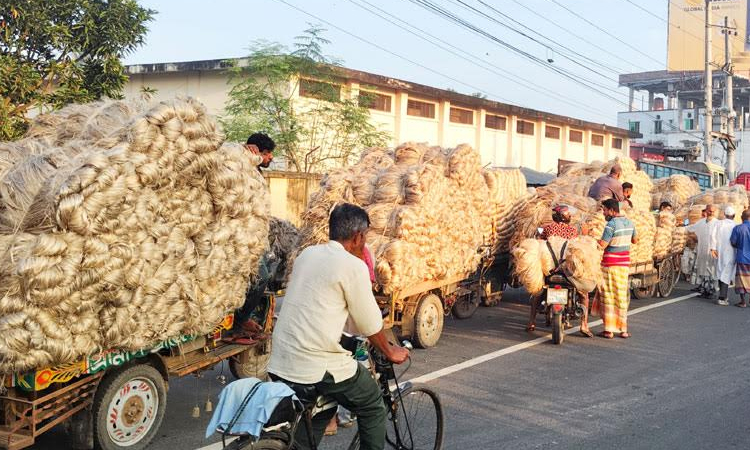News Flash

By Md Aynal Haque
RAJSHAHI, Sept 16, 2025 (BSS) - Since before rising sun, scores of farmers and middlemen with engine-driven vans, human haulers and trolley laden with dry jute are seen appearing in line on both sides of the Rajshahi-Naogaon highway at Nawhata Bazar under Paba Upazila in the district.
Every Monday and Thursday, selling and purchasing of the newly harvested jute continues from 5 am to 9 pm randomly and the brisk business and better price have made jute farmers happy in the region.
On Monday last, jute supply to the nearby bazaar and markets was significant and rushing of huge sellers and purchasers has made the markets vibrant.
Sabbir Ahmed, a jute trader of Shreepur Bazar, said the jute supply will further rise. Currently, the wholesalers are purchasing jute from the farmers directly. Besides, five operating jute mills are also purchasing jute from the growers directly.
This season, the farmers are selling their jute at more Taka 1000 per mound compared to the previous year.
Sabbir said the new jute is now being sold at Taka 3,600 to 3,900 per mound, whereas last year's price was Taka 2,600 to 2,800.
Mamun Or Rashid, a farmer of Puthiapara village under Paba Upazila, sold 22 mounds of jute at Nawhata Bazar at Taka 3,600 per mound on Monday. He has to spend Taka 20,000 for land, seed, fertilizer, labour and irrigation per bigha and get a better yield. Excluding the expenditure, Mamun attained profit worth around Taka 16,000 to 18,000 per bigha.
"I have harvested 28 mounds of jute at a cost of around Taka 55,000 and got Taka 1.05 lakh after selling those," said Chand Sheikh, another farmer of Char Khidirpur village, adding he got profit of around Taka 50,000. He has attained profit of more Taka 1,600 per mound compared to the previous year.
Abdur Razzaque, a farmer from Shreepur village in the same upazila, said the golden era of jute is returning due to rising prices and government initiatives, including the mandatory use of jute bags for packaging public food grains.
He, however, urged the government to take steps to control syndicates of middlemen and traders so that farmers can get fair prices.
Farmers believe that if current trends continue, the cultivation of jute will further increase in the coming years, reviving the past glory of the golden fiber.
Sources close to the Department of Agriculture Extension (DAE) said jute was cultivated on around 17,305 hectares of land in the district this year which is 120 hectares more than the target.
The farmers harvested nine to 10 mounds of jute from per bigha of land on an average due to suitable climatic conditions. There were no crises of decomposing jute due to adequate rainfalls.
"We are encouraging and motivating the farmers towards jute farming as it has market values in both home and abroad," said Umme Salma, Deputy Director of DAE, Rajshahi, adding the jute farmers are making profit this year.
She also said they extended various types of support, including fertilizer, seed, modern technology, pesticides and decomposing support, to the farmers at field level.
Shahana Akhter Jahan, Deputy Director of Department of Agricultural Marketing, said they are monitoring the markets regularly to make sure the farmers get fair prices of jute.
Talking to BSS, President of Rajshahi Chamber of Commerce and Industry Masudur Rahman said jute production in Rajshahi is seeing positive trends with increased cultivation exceeding targets, benefiting from favorable rainfall that aids retting and harvesting.
The marketing of jute involves farmers harvesting and processing the fibers, with the commodity appearing in local markets and then being sold to traders.
He said jute's market price is influenced by quality and demand, though challenges like market fluctuations, syndicates, high transport costs, and the increasing use of plastic bags pose obstacles.
To improve the sector, recommendations include establishing government purchase centers, promoting jute products and providing training to farmers to enhance quality and market value, according to studies from the region.